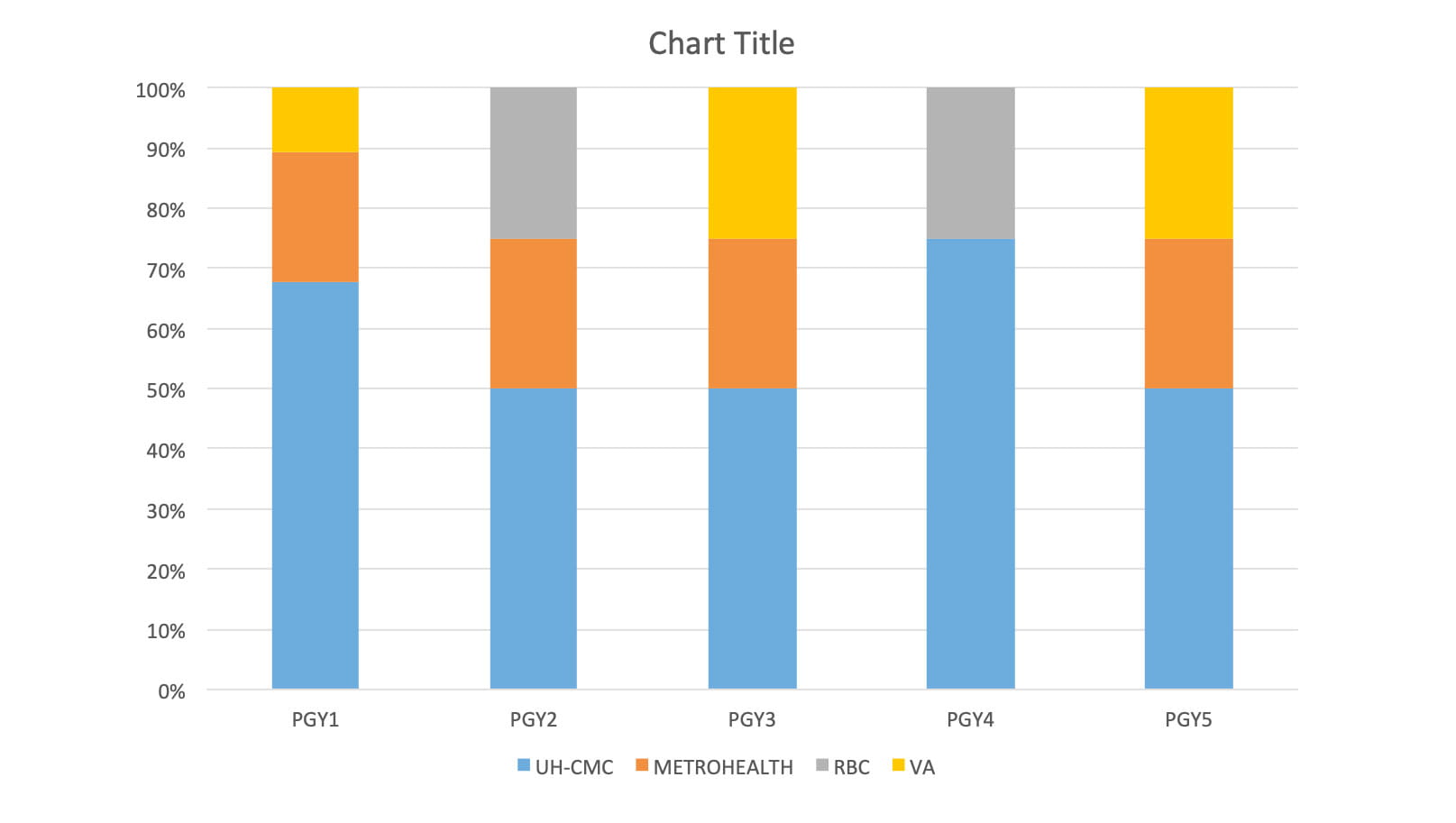Rotations
The Case Western Reserve University/University Hospitals Cleveland Medical Center Otolaryngology Residency Program is a five-year intensive program with rotations in all aspects of ear, nose and throat surgery.

PGY1 Rotations
First-year resident rotations include otolaryngology-head and neck surgery (at University Hospitals, MetroHealth, and VA), general surgery, oral surgery, radiology, neurosurgery and the surgical intensive care unit. A total of six months is spent on ENT rotations during this first year in order to prepare first-year residents for transition to our service full-time the following year.
Goals & Objectives
Educational Objectives and Expectations for the PGY-1 Resident
PGY2 Rotations
Second-year residents are assigned to the services at University Hospitals Cleveland Medical Center, UH Rainbow Babies & Children's Hospital and MetroHealth Medical Center. They are responsible for the pre- and postoperative care of all otolaryngology-head and neck surgery inpatients.
Other assignments include patient care for the in-patient services, a night float rotation, and a consult service rotation. These experiences teach them to take histories, perform complete physical examinations and understand the proper work-up and management of a variety of ENT patients.
Under supervision, along with assisting faculty and senior residents with all major surgical procedures, residents begin to perform procedures commensurate with their growing experience, including:
- Adenotonsillectomy
- Myringotomy with PE tube insertion
- Septoplasty
In consultation with faculty advisors, second-year residents attend the monthly research conference and begin to develop a plan for a specific clinical or basic research project. Further, under the supervision of faculty from the Department of Anatomy at Case Western Reserve University, PGY2 residents act as instructors during the cadaver dissection of the head and neck course for first-year medical students.
Goals & Objectives
Educational Objectives and Expectations for the PGY-2 Resident
PGY2 Goals and Objectives: MetroHealth
PGY2 Goals and Objectives: General/Head & Neck Oncology/Trauma
PGY2 Goals and Objectives: Pediatric Otolaryngology
PGY3 Rotations
Third-year residents in the Otolaryngology Residency Program consolidate the basic skills and knowledge gained the previous year. Rotations are completed at UH Cleveland Medical Center on the subspecialty services (otology, sleep, rhinology, laryngology wand plastics), the Louis Stokes Veterans Administration Medical Center (VAMC) and MetroHealth. Under the supervision of faculty members and senior residents, they perform surgical procedures of intermediate magnitude, including:
- Involvement in reconstructive flaps, under the supervision of faculty members and senior residents
- Maxillofacial trauma
- Neck dissection
Third-year residents also are given more responsibility for managing patients in the clinics of the affiliated hospitals. This permits increased hands-on experience. A protected block of time for clinical and/or basic science research under the direction of a faculty advisor is also a requirement during this training year. A protected block of time for research and quality improvement under the direction of a faculty advisor is also a requirement during this training year.
Goals & Objectives
Educational Objectives and Expectations for the PGY-3 Resident
PGY3 Goals and Objectives: Otology
PGY3 Goals and Objectives: MetroHealth
PGY3 Goals and Objectives: Louis Stokes VA Medical Center
Educational Objectives and Expectations for the Otolaryngology Research Rotation
PGY4 Rotations
Fourth-year residents, with faculty supervision, perform much of the major head and neck surgery and trauma at UH Cleveland Medical Center. Fourth-year residents rotate as acting chief residents through the Division of Pediatric Otolaryngology at UH Rainbow Babies & Children's Hospital where they have responsibility for the inpatient medical service while directly supervising a PGY2 resident. Subspecialty rotations in the following areas complete this busy surgical year:
- Otology
- Facial plastic surgery
- Laryngology
- Rhinology
- Sleep
- Community based ENT
Goals & Objectives
Educational Objectives and Expectations for the PGY-4 Resident
PGY4 Goals and Objectives: General/Head & Neck Oncology/Trauma
PGY4 Goals and Objectives: Pediatric Otolaryngology
PGY4 Goals and Objectives: Laryngology/Facial Plastics/Rhinology
PGY4 Goals and Objectives: Otology rotation
PGY5 Chief Residents
Chief residents assume complete responsibility for the outpatient clinic and inpatient medical care at UH Cleveland Medical Center, MetroHealth Medical Center and the Louis Stokes VA Medical Center. There is also a dedicated PGY5 rotation in otology at UH Cleveland Medical Center. Chief residents have direct supervisory responsibility over all junior members of the house staff as well as medical students.
Chief residents also perform most of the major surgical procedures. They have primary responsibility for teaching medical students at affiliated hospitals and for assisting in giving didactic lectures and conferences for medical students rotating through the department. It is a year of tremendous growth and development that prepares the resident for fellowship, an academic position or a private practice experience.
Goals & Objectives
Educational Objectives and Expectations for the PGY-5 Resident
PGY5 Goals and Objectives: UH Cleveland Medical Center Adult Service
PGY5 Goals and Objectives: MetroHealth Medical Center
PGY5 Goals and Objectives: Louis Stokes VAMC
PGY 5 Goals and Objectives: Otology/Elective Rotation


